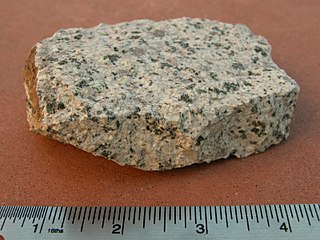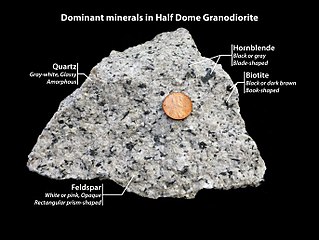
Tonalite is an igneous, plutonic (intrusive) rock, of felsic composition, with phaneritic (coarse-grained) texture. Feldspar is present as plagioclase (typically oligoclase or andesine) with alkali feldspar making up less than 10% of the total feldspar content. Quartz (SiO2) is present as more than 20% of the total quartz-alkali feldspar-plagioclase-feldspathoid (QAPF) content of the rock. Amphiboles and biotite are common accessory minerals.

The Granite Mountains is a small mountain range in eastern San Bernardino County, California, USA, in the Mojave Desert. The range stretches 10.7 mi (17.2 km) from Granite Pass to Budweiser Wash. The highest peaks of this mountain range are an unnamed peak, which is 6,738 ft (2,054 m) in elevation, and Granite Peak, which is 6,766 ft (2,062 m) in elevation.

Intrusive rock is formed when magma penetrates existing rock, crystallizes, and solidifies underground to form intrusions, such as batholiths, dikes, sills, laccoliths, and volcanic necks.

Lamprophyres are uncommon, small-volume ultrapotassic igneous rocks primarily occurring as dikes, lopoliths, laccoliths, stocks, and small intrusions. They are alkaline silica-undersaturated mafic or ultramafic rocks with high magnesium oxide, >3% potassium oxide, high sodium oxide, and high nickel and chromium.

Granodiorite is a coarse-grained (phaneritic) intrusive igneous rock similar to granite, but containing more plagioclase feldspar than orthoclase feldspar.

Monzonite is an igneous intrusive rock, formed by slow cooling of underground magma that has a moderate silica content and is enriched in alkali metal oxides. Monzonite is composed mostly of plagioclase and alkali feldspar.

Granite Mountain is a 7,628-foot (2,325 m) mountain located in Yavapai County, Arizona that covers roughly 12 square miles (31 km2). It was once known as Mount Gurley, for the first governor of the Arizona Territory, John A. Gurley. Its southwest face has a sheer granite cliff approximately 500 feet high that is one of the best locations for rock climbing in the state of Arizona. It is located in the Granite Mountain Wilderness, which is managed as a part of the Prescott National Forest. The mountain stands at the northern end of the Sierra Prietas, and borders Skull Valley on the west, on the northwest by the Santa Maria Mountains, and east by the Williamson Valley.

The Cathedral Peak Granodiorite (CPG) was named after its type locality, Cathedral Peak in Yosemite National Park, California. The granodiorite forms part of the Tuolumne Intrusive Suite, one of the four major intrusive suites within the Sierra Nevada. It has been assigned radiometric ages between 88 and 87 million years and therefore reached its cooling stage in the Coniacian.
The Piégut-Pluviers Granodiorite is situated at the northwestern edge of the Variscan Massif Central in France. Its cooling age has been determined as 325 ± 14 million years BP.

The Vishnu Basement Rocks is the name recommended for all Early Proterozoic crystalline rocks exposed in the Grand Canyon region. They form the crystalline basement rocks that underlie the Bass Limestone of the Unkar Group of the Grand Canyon Supergroup and the Tapeats Sandstone of the Tonto Group. These basement rocks have also been called either the Vishnu Complex or Vishnu Metamorphic Complex. These Early Proterozoic crystalline rocks consist of metamorphic rocks that are collectively known as the Granite Gorge Metamorphic Suite; sections of the Vishnu Basement Rocks contain Early Paleoproterozoic granite, granitic pegmatite, aplite, and granodiorite that have intruded these metamorphic rocks, and also, intrusive Early Paleoproterozoic ultramafic rocks.

Half Dome Granodiorite is granodiorite found in a region on and near Half Dome, in Yosemite National Park, California, United States. The granodiorite forms part of the Tuolumne Intrusive Suite, one of the four major intrusive suites within the Sierra Nevada.

El Capitan Granite is a type of granite, in a large area near El Capitan, in Yosemite National Park, California, United States. The granite forms part of the Tuolumne Intrusive Suite, one of the four major intrusive suites within the Sierra Nevada.
S-type granites are a category of granites first proposed in 1974. They are recognized by a specific set of mineralogical, geochemical, textural, and isotopic characteristics. S-type granites are over-saturated in aluminium, with an ASI index greater than 1.1 where ASI = Al2O3 / (CaO + Na2O +K2O) in mol percent; petrographic features are representative of the chemical composition of the initial magma as originally put forth by Chappell and White are summarized in their table 1.

Kuna Crest Granodiorite, is found, in Yosemite National Park, United States. The granodiorite forms part of the Tuolumne Intrusive Suite, one of the four major intrusive suites within the Sierra Nevada. Of the Tuolumne Intrusive Suite, it is the oldest and darkest rock.

The Tuolumne Intrusive Suite is the youngest and most extensive of the intrusive suites of Yosemite National Park, and also comprises about 1/3 of the park's area. The Suite includes Half Dome Granodiorite, Cathedral Peak Granite, and Kuna Crest Granodiorite.

The Intrusive Suite of Sonora Pass is one of several intrusive suites in Yosemite National Park. These also include
- Fine Gold Intrusive Suite
- Intrusive Suite of Buena Vista Crest
- Intrusive Suite of Jack Main Canyon
- Intrusive Suite of Merced Peak
- Intrusive Suite of Yosemite Valley
- Tuolumne Intrusive Suite

Kuna Crest is a mountain range near Tuolumne Meadows, in Yosemite National Park, California.
I-type granites are a category of granites originating from igneous sources, first proposed by Chappell and White (1974). They are recognized by a specific set of mineralogical, geochemical, textural, and isotopic characteristics that indicate, for example, magma hybridization in the deep crust. I-type granites are saturated in silica but undersaturated in aluminum; petrographic features are representative of the chemical composition of the initial magma. In contrast S-type granites are derived from partial melting of supracrustal or "sedimentary" source rocks.
Johnson Granite Porphyry is found in Tuolumne Meadows, Yosemite National Park.














